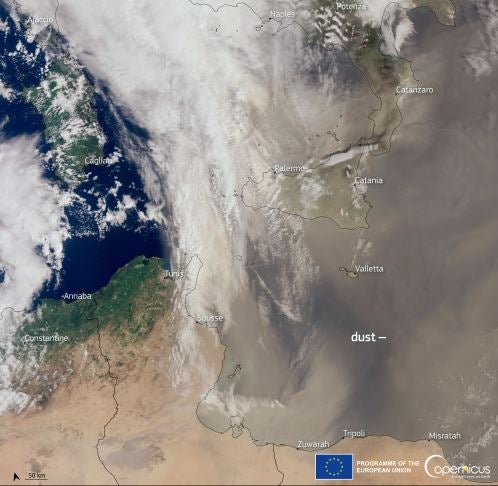Saharan dust cloud causes air pollution across southern Europe
Authorities in Crete recommended children and the elderly stay indoors

A giant dust storm from the Sahara Desert is covering much of southern and eastern Europe, leaving Mediterranean holiday hotspots such as Greece and Malta with air pollution up to 10 times recommended levels.
The dust cloud “has negatively impacted the air quality in affected countries and may cause restricted visibility, and mud rain, a mixture of rain and dust,” said EU monitoring service, Copernicus.
It comes after a similar dust cloud enveloped the Iberian peninsula last week, affecting Spain and Portugal.
Images from the Sentinel-3 satellite show the dust cloud hovering over southern Italy, Malta, Greece, Libya, and Tunisia.
There was reduced visibility in Athens, and authorities on the Greek island of Crete issued a health alert for airborne particles well in excess of 50 micrograms per cubic metre.
Individuals with respiratory issues, young children, and the elderly, were advised to stay indoors where possible.
Theodoros Kolydas, director of Greece’s National Meteorological Centre, said the pollution and air particles should clear in the coming days as the wind direction changes.
“The dust has even reached the Baltic today, while covering a large part of Central and Eastern Europe,” he tweeted.
One Greece resident described the thick air caused by the phenomenon, saying: “It’s like the air is full of custard powder.”
The Met Office at the RAF base in Akrotiri, Cyprus, tweeted a satellite picture showing thick high cloud (red) approaching the island from the west.
Visibility was reduced to between three and nine miles by the dust particles, it said.
In Malta, particulate levels reached 514 micrograms per cubic metre on Wednesday morning, according the Times of Malta. Guidelines by the World Health Organisation say that levels should not exceed an average of 45 over a 24-hour period.
Join our commenting forum
Join thought-provoking conversations, follow other Independent readers and see their replies
Comments
Bookmark popover
Removed from bookmarks